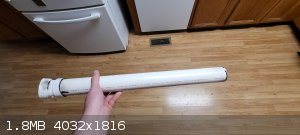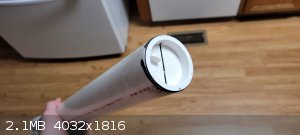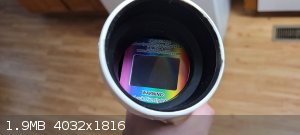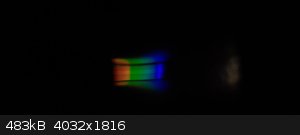vmelkon
National Hazard
   
Posts: 669
Registered: 25-11-2011
Location: Canada
Member Is Offline
Mood: autoerotic asphyxiation
|
|
Building a Spectrometer
Ahoy!
Has anyone built a spectrometer?
How do you make the spectrum as wide as possible? Is it possible to photograph it? It might make it easier to view the image on a PC.
I find that if I project the spectrum on a paper, I need a lot of distance and also the image is very weak.
Signature ==== Is this my youtube page? https://www.youtube.com/watch?v=tA5PYtul5aU
We must attach the electrodes of knowledge to the nipples of ignorance and give a few good jolts.
Yes my evolutionary friends. We are all homos here. |
|
|
JohnnyBuckminster
Harmless

Posts: 40
Registered: 6-6-2018
Member Is Offline
|
|
You can 3D print one, and use your phone to capture the spectrum, se
https://pubs.acs.org/doi/abs/10.1021/acs.jchemed.5b00654
"... a 3D-printable smartphone spectrophotometer that is very inexpensive to build, yet retains the functionality and analytical accuracy necessary to
teach concepts like the Beer–Lambert Law. "
|
|
|
zinc finger
Harmless

Posts: 25
Registered: 30-7-2019
Location: Germany
Member Is Offline
|
|
A wide or full-spectrum light source really is key to a versatile spectro(photo)meter. A relatively cheap halogen lamp can be used for longer
wavelength. For the UV and near UV spectrum more expensive deuterium lamps may be added. Some single light sources like xenon lamps or ultra-high
pressure mercury lamps perform very good over almost the entire UV-Vis spectrum.
DIY photometers often use webcams as detectors, and this seems to work quite nicely. If you have standards you can use any sensor (which is actually
physically able to detect the photons you want to measure) to quantify the intensity of reflected, transmitted etc. light. This quantification is
actually the whole point of a spectroMETER. If you only want to qualitatively determine if certain spectral lines are present, you could instead use
a spectroscope.
Additionally, you usually want to decompose the light before sending it to the detector or even before letting it interact with the sample (or maybe
both). This is best done by utilizing a diffraction grating. In a simple setup, the complete spectrum is measured simultaneously. This has multiple
advantages, but mainly its simplicity is pivotal.
A classic and more robust and accurate setup is a monochromator before the sample. This way the sample only interacts with light of one wavelength at
a time and the detector measures only the light resulting from this interaction. The monochromator setup works by selectively blocking the light of
all but one wavelength leaving a diffraction grating.
[Edited on 23-7-2021 by zinc finger]
|
|
|
vmelkon
National Hazard
   
Posts: 669
Registered: 25-11-2011
Location: Canada
Member Is Offline
Mood: autoerotic asphyxiation
|
|
Hmmm How can I download the PDF or see the text.
Signature ==== Is this my youtube page? https://www.youtube.com/watch?v=tA5PYtul5aU
We must attach the electrodes of knowledge to the nipples of ignorance and give a few good jolts.
Yes my evolutionary friends. We are all homos here. |
|
|
vmelkon
National Hazard
   
Posts: 669
Registered: 25-11-2011
Location: Canada
Member Is Offline
Mood: autoerotic asphyxiation
|
|
Quote: Originally posted by zinc finger  | A wide or full-spectrum light source really is key to a versatile spectro(photo)meter. A relatively cheap halogen lamp can be used for longer
wavelength. For the UV and near UV spectrum more expensive deuterium lamps may be added. Some single light sources like xenon lamps or ultra-high
pressure mercury lamps perform very good over almost the entire UV-Vis spectrum.
DIY photometers often use webcams as detectors, and this seems to work quite nicely. If you have standards you can use any sensor (which is actually
physically able to detect the photons you want to measure) to quantify the intensity of reflected, transmitted etc. light. This quantification is
actually the whole point of a spectroMETER. If you only want to qualitatively determine if certain spectral lines are present, you could instead use
a spectroscope.
Additionally, you usually want to decompose the light before sending it to the detector or even before letting it interact with the sample (or maybe
both). This is best done by utilizing a diffraction grating. In a simple setup, the complete spectrum is measured simultaneously. This has multiple
advantages, but mainly its simplicity is pivotal.
A classic and more robust and accurate setup is a monochromator before the sample. This way the sample only interacts with light of one wavelength at
a time and the detector measures only the light resulting from this interaction. The monochromator setup works by selectively blocking the light of
all but one wavelength leaving a diffraction grating.
[Edited on 23-7-2021 by zinc finger] |
I guess you are talking about absorption: Use a full spectrum light source and pass the light through a solid or liquid sample, right?
That interests me as well but I was thinking about emission: for example, a low pressure neon tube that you ionize with high voltage or maybe I want
to look a the light of a LED or fluorescent tube.
Signature ==== Is this my youtube page? https://www.youtube.com/watch?v=tA5PYtul5aU
We must attach the electrodes of knowledge to the nipples of ignorance and give a few good jolts.
Yes my evolutionary friends. We are all homos here. |
|
|
zinc finger
Harmless

Posts: 25
Registered: 30-7-2019
Location: Germany
Member Is Offline
|
|
Yep, I mainly had this in mind.
Now I understand that with "spectrum as wide as possible" you probably meant the detector and optics not the light source itself. The devices you are
looking for are often called optical spectrum analyzer. To ensure a wide spectrum you have to check the parameters of each individual component:
the diffraction grating has a spectral range (typically ~200 - 1000 nm)
Lenses have to be (1) transmissive to the wavelength of light (for UV typically quartz glass)
lenses should (2) influence the light independently of its wavelength (achromatic, apochromatic)
the detector must (1) be abled to pic up the wavelength in question - smartphone cameras usually pic up some near IR and no UV
the detector should (2) be sensitive enough to pic up small amounts of light
The sensor may be the most difficult part, so here is some more information on this:
Different detector types exist. In commercial units two (or 3) types dominate the market:
sensor arrays in modern units have multiple sensors each tuned for a different part of the spectrum
photo multiplier tubes (PMT) in older and some modern devices which are often sensitive over the entire spectrum while being super sensitive.
special photo diodes exist which are (almost) capable of replacing PMTs
|
|
|
unionised
International Hazard
    
Posts: 5102
Registered: 1-11-2003
Location: UK
Member Is Offline
Mood: No Mood
|
|
Lenses are problematic- the focal length varies with wavelength and they absorb light.
If you use a diffraction grating you also usually need some sort of "order sorting" filter.
|
|
|
JohnnyBuckminster
Harmless

Posts: 40
Registered: 6-6-2018
Member Is Offline
|
|
Building a "scientific grade" spectrometer for absorption (or emission) is a challenge, you have to address the optical layout, the mechanical design,
sensors, electronics, and the read out software. However, there are second hand options on eBay, for example the Ocean Optics USB2000 is surprisingly
good.
For a DIY project look here
https://www.colorado.edu/lab/damrauergroup/modular-spectrome...
https://youtu.be/T_goVwwxKE4
|
|
|
macckone
International Hazard
    
Posts: 2159
Registered: 1-3-2013
Location: Over a mile high
Member Is Offline
Mood: Electrical
|
|
vmelkon,
I think there is a thread with the supplemental information.
Check scihubtw.tw for papers.
|
|
|
Bonee
Harmless

Posts: 29
Registered: 20-12-2010
Member Is Offline
Mood: No Mood
|
|
There is a Belgian engineer whos page has myriad of good info on diy spectrometry builds/components/theory etc, also he has built a ~2k euro ~15cm
resolution raman spectrometer. He may have already advertesid it here I am not sure but I think it definitely has a place here.
https://www.thepulsar.be/archives/
|
|
|
Rainwater
National Hazard
   
Posts: 799
Registered: 22-12-2021
Member Is Offline
Mood: indisposition to activity
|
|
I build mine out of a 36in pice of pipe. A 22 degree fitting an end cap, a fractional gradient off the online store. Spray paint Nd a card board box.
Total was about $15usd.
The real trick is aligning everything just right to take a clean picture. Need a camera with manual focus or an Infinite focal lens. That was taken
with my phone. A cctv with ir capabilities may prove better than a color image given their ability to detect ir
The software you use to analyze the spectrum is where the magic is.
   
"You can't do that" - challenge accepted
|
|
|
Ubya
International Hazard
    
Posts: 1232
Registered: 23-11-2017
Location: Rome-Italy
Member Is Offline
Mood: I'm a maddo scientisto!!!
|
|
http://www.sciencemadness.org/talk/viewthread.php?tid=154260
I actually made one 2 years ago.
I was recently going to revisit that project using a linear CCD instead of a normal webcam, so instead of having 1080 pixels at most i can have nearly
4k with a TCD1304, the issue is the driver board, a normal arduino doesn't have enough memory, so i have to use something else and program it
accordingly.
A good source of informations for this project is at https://tcd1304.wordpress.com/
I also thought of making a scanning monocromator instead of a diode array spectrophotometer, but for a beginners project it adds quite a lot of
complexity, less DIY moving parts means less error in the final measurement.
UV spectroscopy is very useful in organic chemistry, but deuterium lamps are not cheap at all, and plastic transmission diffraction gratings won't
works since they absorb strongly under 330nm (PET plastic)
Common CCDs also are not that sensible, compared with a photomultiplier with a monochromator, so they are better suited for not very diluted
solutions, or for solution with strong absorbance.
I also tried looking around for used parts, i found locally a used monochromator, but even if it was used, and probably from the 80s, it was still
around 100 euros.
If you need to go the cheap route, slapping some plastic diffraction grating on a webcam and putting it in a box works
If you need more than ballpark measurings, getting a complete unit from the used market is the best solution
---------------------------------------------------------------------
feel free to correct my grammar, or any mistakes i make
---------------------------------------------------------------------
|
|
|